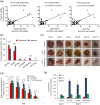Polyamines release the let-7b-mediated suppression of initiation codon recognition during the protein synthesis of EXT2
- PMID: 27650265
- PMCID: PMC5030709
- DOI: 10.1038/srep33549
Polyamines release the let-7b-mediated suppression of initiation codon recognition during the protein synthesis of EXT2
Abstract
Proteoglycans (PGs), a family of glycosaminoglycan (GAG)-protein glycoconjugates, contribute to animal physiology through interactions between their glycan chains and growth factors, chemokines and adhesion molecules. However, it remains unclear how GAG structures are changed during the aging process. Here, we found that polyamine levels are correlated with the expression level of heparan sulfate (HS) in human skin. In cultured cell lines, the EXT1 and EXT2 enzymes, initiating HS biosynthesis, were stimulated at the translational level by polyamines. Interestingly, the initiation codon recognition by 43S preinitiation complex during EXT2 translation is suppressed by let-7b, a member of the let-7 microRNA family, through binding at the N-terminal amino acid coding sequence in EXT2 mRNA. Let-7b-mediated suppression of initiation codon depends on the length of 5'-UTR of EXT2 mRNA and its suppression is inhibited in the presence of polyamines. These findings provide new insights into the HS biosynthesis related to miRNA and polyamines.
Figures






Similar articles
-
Polyamines stimulate the CHSY1 synthesis through the unfolding of the RNA G-quadruplex at the 5'-untraslated region.Biochem J. 2018 Dec 6;475(23):3797-3812. doi: 10.1042/BCJ20180672. Biochem J. 2018. PMID: 30401686
-
Biosynthesis of heparan sulfate in EXT1-deficient cells.Biochem J. 2010 May 27;428(3):463-71. doi: 10.1042/BJ20100101. Biochem J. 2010. PMID: 20377530
-
Heparan sulfate biosynthesis enzymes EXT1 and EXT2 affect NDST1 expression and heparan sulfate sulfation.Proc Natl Acad Sci U S A. 2008 Mar 25;105(12):4751-6. doi: 10.1073/pnas.0705807105. Epub 2008 Mar 12. Proc Natl Acad Sci U S A. 2008. PMID: 18337501 Free PMC article.
-
The exostosin family: proteins with many functions.Matrix Biol. 2014 Apr;35:25-33. doi: 10.1016/j.matbio.2013.10.001. Epub 2013 Oct 12. Matrix Biol. 2014. PMID: 24128412 Review.
-
EXTL2 controls liver regeneration and aortic calcification through xylose kinase-dependent regulation of glycosaminoglycan biosynthesis.Matrix Biol. 2014 Apr;35:18-24. doi: 10.1016/j.matbio.2013.10.010. Epub 2013 Oct 24. Matrix Biol. 2014. PMID: 24176719 Review.
Cited by
-
A novel cytoskeletal action of xylosides.PLoS One. 2022 Jun 28;17(6):e0269972. doi: 10.1371/journal.pone.0269972. eCollection 2022. PLoS One. 2022. PMID: 35763520 Free PMC article.
-
Translational Regulation of Clock Genes BMAL1 and REV-ERBα by Polyamines.Int J Mol Sci. 2021 Jan 28;22(3):1307. doi: 10.3390/ijms22031307. Int J Mol Sci. 2021. PMID: 33525630 Free PMC article.
-
Functional roles of polyamines and their metabolite acrolein in eukaryotic cells.Amino Acids. 2021 Oct;53(10):1473-1492. doi: 10.1007/s00726-021-03073-w. Epub 2021 Sep 21. Amino Acids. 2021. PMID: 34546444 Review.
-
Characterization of chondroitin sulfate in stem cells derived from umbilical cord blood in rats.PLoS One. 2022 Jan 25;17(1):e0262854. doi: 10.1371/journal.pone.0262854. eCollection 2022. PLoS One. 2022. PMID: 35077481 Free PMC article.
-
KLF4 is required for suppression of histamine synthesis by polyamines during bone marrow-derived mast cell differentiation.PLoS One. 2020 Feb 26;15(2):e0229744. doi: 10.1371/journal.pone.0229744. eCollection 2020. PLoS One. 2020. PMID: 32101568 Free PMC article.
References
-
- Roden L. Structure and metabolism of connective tissue proteoglycans. 267–371 (Plenum press, New York, 1980).
Publication types
MeSH terms
Substances
LinkOut - more resources
Full Text Sources
Other Literature Sources
Molecular Biology Databases
Research Materials
Miscellaneous

